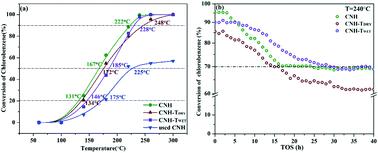当前位置:
X-MOL 学术
›
Catal. Sci. Technol.
›
论文详情
Our official English website, www.x-mol.net, welcomes your
feedback! (Note: you will need to create a separate account there.)
Regeneration mechanism of a deactivated zeolite-supported catalyst for the combustion of chlorinated volatile organic compounds
Catalysis Science & Technology ( IF 4.4 ) Pub Date : 2020-10-03 , DOI: 10.1039/d0cy01060j Pengfei Sun 1, 2, 3, 4, 5 , Jingkun Chen 1, 2, 3, 4 , Shuaiying Zai 1, 2, 3, 4 , Shan Gao 1, 2, 3, 4, 5 , Xiaole Weng 1, 2, 3, 4, 5 , Zhongbiao Wu 1, 2, 3, 4, 5
Catalysis Science & Technology ( IF 4.4 ) Pub Date : 2020-10-03 , DOI: 10.1039/d0cy01060j Pengfei Sun 1, 2, 3, 4, 5 , Jingkun Chen 1, 2, 3, 4 , Shuaiying Zai 1, 2, 3, 4 , Shan Gao 1, 2, 3, 4, 5 , Xiaole Weng 1, 2, 3, 4, 5 , Zhongbiao Wu 1, 2, 3, 4, 5
Affiliation

|
Industrial catalysis is confronted with the common problem of catalyst deactivation. For the field of chlorinated volatile organic compound (Cl-VOC) elimination, it is hard to find an effective solution for the regeneration and re-use of deactivated catalysts within industrial settings. In this work, the performance of a metal-exchanged H-zeolite (Cu–Nb/HZSM-5) catalyst is tested for chlorobenzene (CB) combustion by different catalyst regeneration strategy. By confirming the related reaction mechanism via in situ DRIFTS, GC-MS, and PR-IR, the catalysts were analyzed in terms of their carbon deposition, surface elemental content, and acidity, before and after the regeneration. It was found that humid air exhibited an excellent catalyst restoration effect at a temperature of 400 °C, the adsorbed coke and chlorine on the surface of the deactivated catalyst were mostly removed, and the catalytic performance was recovered to 100% of that of the fresh catalyst.
中文翻译:

失活的沸石负载型催化剂燃烧氯化挥发性有机化合物的再生机理
工业催化面临催化剂失活的普遍问题。对于氯化挥发性有机化合物(Cl-VOC)的消除领域,在工业环境中很难找到有效的解决方案来再生和再利用失活的催化剂。在这项工作中,通过不同的催化剂再生策略,测试了金属交换的H型沸石(Cu-Nb / HZSM-5)催化剂对氯苯(CB)燃烧的性能。通过原位确认相关反应机理DRIFTS,GC-MS和PR-IR分析了再生前后的碳沉积,表面元素含量和酸度。发现湿空气在400℃的温度下表现出优异的催化剂修复效果,钝化催化剂表面上吸附的焦炭和氯大部分被除去,催化性能恢复到新鲜催化剂的100%。催化剂。
更新日期:2020-11-21
中文翻译:

失活的沸石负载型催化剂燃烧氯化挥发性有机化合物的再生机理
工业催化面临催化剂失活的普遍问题。对于氯化挥发性有机化合物(Cl-VOC)的消除领域,在工业环境中很难找到有效的解决方案来再生和再利用失活的催化剂。在这项工作中,通过不同的催化剂再生策略,测试了金属交换的H型沸石(Cu-Nb / HZSM-5)催化剂对氯苯(CB)燃烧的性能。通过原位确认相关反应机理DRIFTS,GC-MS和PR-IR分析了再生前后的碳沉积,表面元素含量和酸度。发现湿空气在400℃的温度下表现出优异的催化剂修复效果,钝化催化剂表面上吸附的焦炭和氯大部分被除去,催化性能恢复到新鲜催化剂的100%。催化剂。









































 京公网安备 11010802027423号
京公网安备 11010802027423号